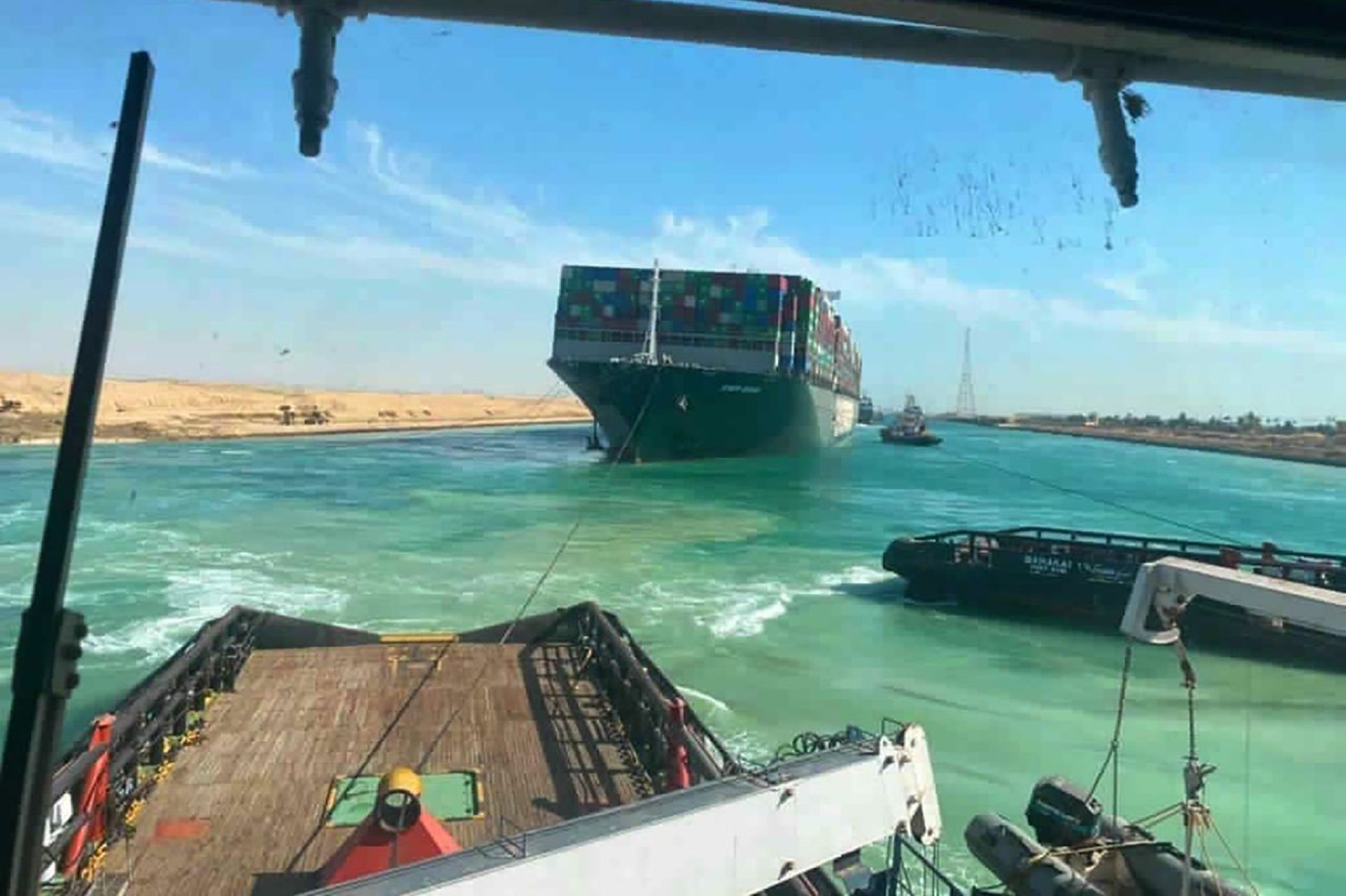Stronger tidal effect made it easier to partially float the Ever Given but also gave engineers a hard deadline
SUEZ, Egypt—To get the giant container ship blocking the Suez Canal unstuck, engineers needed the stars to align. Actually, the sun, Earth and moon.
After several days trying to dislodge the Ever Given cargo ship, which had veered off course and embedded itself in the side of the canal, the salvage team pinned their hopes on this week’s full moon, when, beginning Sunday, water levels were set to rise a foot-and-a-half higher than normal high tides. That would make it easier to pull the 1,300-foot vessel out from the side of the canal without unloading a large number of the 18,000 or so containers it was carrying.
The engineers would have to work fast to make the most of this narrow window. The effect would only last a few days. But it would be their best shot at freeing up the canal—and with it, billions of dollars’ worth of global trade flows in the process.
Tides are higher whenever there is a full or new moon, which occurs when the moon is in direct alignment with the sun, with either the Earth or moon in the middle of the three. This causes a greater gravitational pull on the Earth. As a result, high tides are higher, and low tides are lower. They are known as spring tides and occur twice a month.
This time the effect was amplified by the first supermoon of the year, when a full moon coincides with the closest point to Earth in its elliptical orbit. Supermoons occur several times a year, and this one is known as the worm moon, for the earthworms that begin to appear in the soil in the Northern Hemisphere at this time of year.
When it became clear that tugboats alone wouldn’t be able to dislodge the Ever Given, the rescue effort began looking to the supermoon’s pull on the tides and how it might help free the stranded vessel.
According to people involved in the operation, much of the work to dredge hundreds of thousands of cubic feet of sand was undertaken with the higher water levels in mind. Dredgers were assigned to the area and worked around the clock.
Lars Mikael Jensen, head of A.P. Moller-Maersk A/S’s global ocean network, said Monday was a particularly important day, when water levels began to peak.
“In the last couple of days all the available tug power has been allocated,” he said. Higher tides could give the salvage team the lift it needed to refloat the Ever Given.
Missing the deadline would be costly. Vessels waiting in the Mediterranean and Red Seas to traverse the 120-mile canal would face the prospect of a far longer journey around the Cape of Good Hope in southern Africa to reach their destinations in Europe and Asia. Others that hadn’t yet reached the area would also have had to make similar decisions.
Sea-Intelligence, a Copenhagen-based data group, estimated that the knock-on effect of rerouting ships around Africa or through the Panama Canal would effectively cut the world’s container shipping capacity by about 6% over the long term because vessels would spend more time sailing on longer voyages.
Egyptian President Abdel Fattah Al Sisi, facing arguably one of the biggest tests of his seven-year rule, ordered the Suez Canal Authority that runs the waterway to begin working on a contingency plan for the laborious process of unloading the containers if the refloat effort failed. The U.S., China, Greece and the United Arab Emirates all had offered to help.
The rescue team wanted to avoid that outcome at any cost.
“It’s really a last resort,” said Nick Sloane, a maritime salvage expert who led the high-profile effort to float the stricken cruise ship Costa Concordia off the coast of Italy in 2012.
R aising the stakes further, seven days after a spring tide, the sun and moon are at right angles to each other in relation to the earth. At that point, the bulge in the ocean caused by the gravitational pull of the sun partially cancels out the influence of the moon, meaning that tides are lower. It would take significantly longer to pull loose the Ever Given in those conditions, salvage experts said.
It wasn’t initially clear to authorities how serious the situation was when the ship, operated by Taiwan-based Evergreen Group, hit the eastern side of the Suez Canal during a seasonal sandstorm known as a khamsin at around 7.30 a.m. on March 23, burying its nose 16 feet into the rocky soil.
Egyptian investigators have indicated that high winds were likely a factor, but were also looking at the possibility of human error or a mechanical failure. They also highlighted the danger of what are known as bank effects, which can pull or push a large ship close to shore when it is navigating in a shallow, narrow channel.
Based on an assessment by a team of divers, the Suez Canal Authority allowed additional vessels into the waterway, thinking the Ever Given would soon be freed by tugboats and earthmovers.
An image of a solitary mechanical digger attempting to unstick the hulking carrier quickly spread on the internet, where people used it to depict such monumental challenges as holding back threats such as the Covid-19 pandemic or climate change, or even just stacking a dishwasher correctly.
“I’m quite aware that this picture went viral and people thought this was our only procedure,” Osama Rabie, chairman of the Suez Canal Authority, said at a press conference Saturday.
When the initial effort failed, Mr. Rabie deployed dredgers to dig out sand from around the vessel and help tugboats move it a little bit further out each day at high tide.
Dutch salvage operator Smit Internationale N.V. flew in a team early Thursday morning to help with the new strategy. By Friday, the authority had completed about 87% of the dredging work it thought was needed to free the ship, removing close to 600,000 cubic feet, or roughly equivalent to seven Olympic-sized swimming pools of sand and mud.
“We got to dig deep to get it loose…Nothing else will happen until it’s done,” a person participating in the salvage operation said last week as the pressure started to build.
Their progress helped the salvagers turn on the ship’s propeller and rudder for the first time, raising the possibility on Friday evening that the ship might be pulled free by tugboats. But hopes were dashed when the daily tide receded and the ship’s bow remained wedged in the side of the canal, the authority said.
On Saturday, the team was using 12 tugboats—two at the front, six pushing the back and four pulling the stern—to try to dislodge the Ever Given. The dredgers by then had removed 950,000 cubic feet of sand and dug to a depth of 60 feet around the ship.
By Sunday night, the supermoon had caused tidal levels to exceed 6½ feet, some 19 inches above the high tide March 23 when the Ever Given ran aground. The salvage team’s best chance of success was approaching.
At 2 a.m. local time, the operation was aided by the arrival of a Dutch-flagged tugboat, the Alp Guard, with a pulling power of 285 metric tons, a major boost compared with the other tugboats working on the vessel, such as the Suez-based Baraka 1 that pulled at 160 tons.
‘When this big tug came, immediately the stern of the ship was released from the bank.’
— Captain Wessam Hafez, veteran chief pilot on the canal
Then, the days of dredging and digging began to pay off as the tugboats revved up their engines and began maneuvering the Ever Given in the higher tide, a person on another tugboat said.
The effort managed to dislodge the ship’s bow from the eastern side of the canal at about 5 a.m. and shift its stern 330 feet from the western side into the waterway, compared with 13 feet when it stuck, the authority said.
“We were working four days with our tugs,” said Captain Wessam Hafez, a veteran chief pilot on the canal. “When this big tug came, immediately the stern of the ship was released from the bank.”
A pair of tugboats pulled from the right side of the stern while others pushed from the opposite side. Others slowly pulled the front-left side of the ship out toward the center of the canal, slowly levering its bow out of the hole it had gouged in the side of the channel.
As the tide fell, moving out south toward the Red Sea, the ship slowly began to break clear. Video footage from the scene recorded some of the crews cheering “Allahu akbar,” or God is great, as dawn broke.
When water levels rose again toward midday, work began on finishing the job. Hopes for a swift end to the drama were initially dashed by currents and high winds working against the salvage team. But then, in the bright afternoon sunshine, the ship gently drifted toward the center of the canal, harnessed by an array of tugboats.
Mr. Sloane, the maritime salvage expert, said the few additional inches brought by the spring tides made a critical difference, adding thousands of tons of buoyancy to float the Ever Given.
“On a big ship like that, the impact is quite a lot,” he said.
Corrections & Amplifications The effort managed to dislodge the ship’s bow at about 5 a.m. moved its stern 330 feet from the western side compared with 13 feet when it was stuck. An earlier version incorrectly stated the distances of the stern. (Corrected on 3/30)
Stephen Kalin and Costas Paris contributed to this article.




